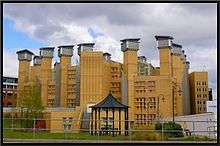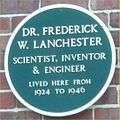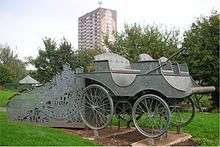Frederick W. Lanchester
| Frederick W. Lanchester | |
|---|---|
.jpg) | |
| Born |
23 October 1868 Lewisham, London |
| Died |
8 March 1946 (aged 77) Birmingham |
| Nationality | English |
|
Engineering career | |
| Significant advance | |
| Significant awards | |
.jpg)
Frederick William Lanchester, Hon FRAeS FRS[1] (23 October 1868 – 8 March 1946) was an English polymath and engineer who made important contributions to automotive engineering, aerodynamics and co-invented the topic of operations research.
He was also a pioneer British motor car builder, a hobby which resulted in his developing a successful car company, and is considered one of the "big three" English car engineers, the others being Harry Ricardo and Henry Royce.
Biography
Lanchester was born at Lewisham, London to Henry Jones Lanchester, an architect, and his wife Octavia, a tutor. He was the fourth of eight children, his older brother Henry Vaughan Lanchester also becoming an architect. When he was a year old, his father relocated the family to Brighton, and young Frederick attended a preparatory school and a nearby boarding school, where he did not distinguish himself. He himself, thinking back, remarked that, "it seemed that Nature was conserving his energy". However, he did succeed in winning a scholarship to the Hartley Institution, in Southampton, and after three years won another scholarship, to Kensington College, which is now part of Imperial College. He supplemented his instruction in applied engineering by attending evening classes at Finsbury Technical School. Unfortunately, he ended his education without having obtained a formal qualification.
When he completed his education in 1888, he acquired a job as a Patent Office draughtsman for £3 a week. About this time he registered a patent for an isometrograph, a draughtsman’s instrument for hatching, shading and other geometrical design work.[2]
In 1919, at the age of fifty-one, Lanchester married Dorothea Cooper, the daughter of Thomas Cooper, the vicar of St Peter’s Church at Field Broughton in Lancashire. The couple relocated to 41 Bedford Square, London, but in 1924 Lanchester built a house to his own design (Dyott End) in Oxford Road, Moseley. The couple remained there for the rest of their life together but did not have any children.[3]
He was elected a Fellow of the Royal Society in 1922,[1] and in 1926 the Royal Aeronautical Society awarded him a fellowship and a gold medal.
In 1925 Lanchester founded a company named Lanchester Laboratories Ltd., to perform industrial research and development work. Although he developed an improved radio and gramophone speaker, he was unable to market it successfully because of the Great Depression. He continued, overworking, until in 1934 his health failed and the company was forced to close. He was diagnosed eventually with Parkinson's disease and was reportedly much grieved that this, along with cataracts in both eyes, prevented him from "doing any official job" during the Second World War.[4]
He was awarded gold medals by the Institution of Civil Engineers in 1941 and the Institution of Mechanical Engineers in 1945.
Although he achieved his fame by his creative brilliance as an engineer, Frederick Lanchester was a man of diverse interests, blessed with a fine singing voice.[4] Using the pseudonym of Paul Netherton-Herries he published two volumes of poetry.[4]
Lanchester, who had never been successful commercially, lived the remainder of his life in straitened circumstances, and it was only through charitable help that he was able to remain in his home. He died at his home, Dyott End, on 8 March 1946.[2]
Work
Gas engines
Near the end of 1888, Lanchester went to work for the Forward Gas Engine Company of Saltley, Birmingham as assistant works manager. His contract of employment included a clause stating that any technical improvements that he made would be the intellectual property of the company. Lanchester wisely struck this out before signing. This action was prescient, for in 1889 he invented and patented a Pendulum Governor to control engine speeds, for which he received a royalty of ten shillings for each one fitted to a Forward Engine. In 1890 he patented a Pendulum Accelerometer, for recording the acceleration and braking of road and rail vehicles.
After the death of the current works manager, Lanchester was promoted to his job. He then designed a new gas engine of greater size and power than any produced by the company before. The engine was a vertical one with horizontal, opposed poppet valves for inlet and exhaust. The engine had a very low compression ratio, but was very economical to operate.
In 1890 Lanchester patented a self-starting device for gas engines. He subsequently sold the rights for his invention to the Crossley Gas Engine Company for a handsome sum.
He rented a small workshop next to the Forward Company’s works and used this for experimental work of his own. In this workshop, he produced a small vertical single cylinder gas engine of 3 bhp (2.2 kW), running at 600 rpm. This was coupled directly to a dynamo, which Lanchester used to light the Company’s office and part of the factory.[2]
Petrol engines
Lanchester began to find the conflict between his job as works manager and his research work irksome. Therefore, in 1893, he resigned his job in favour of his younger brother George. At about the same time, he produced a second engine type similar in design to his previous one but operating on benzene at 800 rpm. An important part of his new engine was the revolutionary carburettor, for mixing the fuel and air correctly. His invention was known as a wick carburettor, because fuel was drawn into a series of wicks, from where it was vapourised. He patented this invention in 1905.
Lanchester installed his new petrol engine in a flat-bottomed launch, which the engine drove via a stern paddle wheel. Lanchester built the launch in the garden of his home in Olton, Warwickshire. The boat was launched at Salter’s slipway in Oxford in 1904, and was the first motorboat built in Britain.[2]
Cars
Having put a petrol engine in a boat, the next logical step was to use it for road transport. Lanchester set about designing a four-wheeled vehicle to be driven by a petrol engine. He designed a new petrol engine of 5 bhp (3.7 kW), with two crankshafts rotating in opposite directions, for exemplary smoothness,[5] and air cooling by way of vanes mounted on the flywheel.[6] There was a revolutionary[6] epicyclic gearbox (years before Henry Ford adopted it)[6] giving two forward speeds plus reverse, and which drove the rear wheels via chains. With a walnut body, it seated three, side by side.[6] (By contrast, Rudolf Egg's tricycle had a 3 hp (2.2 kW) 402 cc {24½in3)[7] de Dion-Bouton single and was capable of 40 km/h {25 mph},[7] and Léon Bollée's trike a 1.9 kW {2.5 hp} 650 cc (40 in3)[7] engine of his own design, capable of over 50 km/h {30 mph}.[7]
Lanchester's car was completed in 1895 and given its first test run in 1896, and proved to be unsatisfactory, being underpowered and having transmission problems. Lanchester designed a new 8 hp (6 kW) 2,895 cc (177 in3)[6] air-cooled engine with two horizontally opposed cylinders, still with two crankshafts. He also re-designed the epicyclic gearbox and combined it with the engine. A driveshaft connected the gearbox to a live axle. The new engine and transmission were fitted to the original 1895 car.
Lanchester had relocated his business to larger workshops in Ladywood Road, Fiveways, Birmingham as work on the car progressed and had also sold his house to help finance the cost of his research. A second car was then built with the same engine and transmission but with Lanchester’s own design of cantilever suspension. This was completed in 1898 and won a Gold Medal for its design and performance at the Automobile Exhibition and Trials at Richmond. It became known as the Gold Medal Phaeton.
In 1898, Lanchester designed a water-cooled version of his 8 bhp (6.0 kW) engine, which was fitted to a boat, driving a propeller. In 1900 the Gold Medal Phaeton was entered for the first Royal Automobile Club 1,000 Miles Trial and completed the course successfully after one mechanical failure en route.[2]
Lanchester Engine Company
In 1899 Lanchester and his brothers created the Lanchester Engine Company in order to manufacture cars that could be sold to the public. A factory was acquired in Montgomery Street, Sparkbrook, Birmingham, known as the Armourer Works. In his new factory, Lanchester designed a new ten horsepower twin cylinder engine. He decided to use a worm drive transmission and designed a machine to cut the worm gears. He patented this machine in 1905 and it continued for 25 years to produce all of the Lanchester worm gears. He also introduced the use of splined shafts and couplings in place of keys and keyways, another innovation that he patented. The back axle had roller bearings and Lanchester designed the machines to make these. His car was designed with the engine placed between the two front seats rather than at the front, and also had a side mounted tiller rather than a steering wheel. The transmission also included a system similar to modern disc brakes that clamped the clutch disc for braking, rather than using a separate system as in most cars.[2]
The new 10 hp (7.5 kW) car appeared in 1901 and remained in production until 1905, with only minor design modifications. He became a friend of Rudyard Kipling and would send him experimental models to test. In 1905, Lanchester produced a 20 hp (14.9 kW) four-cylinder engine, and in 1906 he produced a 28 hp (20.9 kW) six-cylinder engine. He was concerned with vibration and so introduced a crankshaft vibration damper and a harmonic balancer, both of which he patented.
The Lanchester Engine Company sold about 350 cars of various designs between 1900 and 1904, when they became bankrupt due to the incompetence of the Board of Directors. It was immediately reformed as The Lanchester Motor Company. Lanchester became disillusioned with the activities of the company’s directors, and in 1910 resigned as general manager, becoming their part-time consultant and technical adviser. His brothers, George and Frank, assumed technical and administrative responsibility for the company. In 1909 Lanchester also became technical consultant of The Daimler Company Limited for which he designed the integral hybrid KPL double-deck bus, and subsequently of its parent company Birmingham Small Arms.
During this period he also experimented with fuel injection, turbochargers, added steering wheels in 1907 and invented the accelerator pedal to help control engine operation, which previously would not cease if the operator had problems. He invented (or was the first to use) detachable wire wheels, bearings that were pressure-fed with oil, stamped steel pistons, piston rings, hollow connecting rods, the torsional vibration damper, and the harmonic balancer.
Aeronautics
Lanchester began to study aeronautics seriously in 1892, eleven years before the first successful powered flight. Whilst crossing the Atlantic on a voyage to the United States, Lanchester studied the flight of herring gulls, seeing how they were able to use motionless wings to catch up-currents of air. He measured various birds to see how the centre of gravity compared with the centre of support. As a result of his deliberations, Lanchester, eventually formulated his circulation theory of flight. This is the basis of aerodynamics and the foundation of modern aerofoil theory. In 1894 he tested his theory on a number of models. In 1897 he presented a paper entitled "The soaring of birds and the possibilities of mechanical flight" to the Physical Society, but it was rejected, being too advanced for its time. Lanchester realised that powered flight required an engine with a much greater power-to-weight ratio than any existing engine. He proposed to design and build such an engine, but was advised that no one would take him seriously.[2]
Lanchester was discouraged by the attitude to his aeronautical theory, and concentrated on automobile development for the next ten years. In 1907 he published a two-volume work, Aerial Flight, dealing with the problems of powered flight. In it, he developed a model for the vortices that occur behind wings during flight,[8] which included the first full description of lift and drag. His book was not well received in England, but created interest in Germany where the scientist Ludwig Prandtl mathematically confirmed the correctness of Lanchester’s vortex theory. In his second volume, Lanchester turned his attention to aircraft stability, aerodonetics, developing his phugoid theory which contained a description of oscillations and stalls. During this work he outlined the basic layout used in most aircraft since then. Lanchester’s contribution to aeronautical science was not recognised until the end of his life.
In 1909 Herbert Henry Asquith's Royal Advisory Committee on Aeronautics was established, and Lanchester was appointed a member. Lanchester guessed correctly that aircraft would play an increasingly important part in warfare, unlike the military command which envisioned warfare as continuing much the same way it had in the past.
The same year, 1909, Lanchester patented a contra-rotating propeller.[9]
Lanchester’s Power Laws
During World War I Lanchester was particularly interested in predicting the outcome of aerial battles. In 1916 he published his ideas on aerial warfare in a book entitled "Aircraft in Warfare: the Dawn of the Fourth Arm", which included a description of a series of differential equations that are known now as Lanchester's Power Laws. These laws described how two forces would attrit each other in combat, and demonstrated that the ability of modern weapons to operate at long ranges dramatically changed the nature of combat—a force that was twice as large had been twice as powerful in the past, but now it was four times, the square of the quotient.[10][11]
Lanchester's Laws were originally applied practically in the United States to study logistics, where they developed into operations research (OR) (operational research in UK usage). OR techniques are now widely used, perhaps most so for business.
The post-war company
After the war, the company introduced the more conventional Forty engine, a rival for the Rolls-Royce 40/50 hp; it was joined in 1924 by an overhead cam 21 hp (15.7 kW) six cylinder engine. In 1921 Lanchester was the first company to export left-hand drive cars. Tinted glass was also introduced on these cars for the first time. A 4440 cc straight eight engine was introduced at the 1928 Southport Rally, again with overhead cams: it proved to be the last "real" Lanchester, in 1931 the company was acquired by B.S.A., who had also owned the Daimler Company since 1909. From then until 1956, Lanchester cars were built at the Daimler factory in Coventry as sister cars with Daimler, like R-R with Bentley [ref Lanchester Legacy trilogy].
Lanchester's Legacy
Lanchester was respected by most fellow engineers as a genius, but he did not have the business acumen to convert his inventiveness to financial gain. Whereas James Watt had found an able business partner in Matthew Boulton, who managed business affairs, Lanchester had no such assistance. During most of his career he lacked financial backing to be able to develop his ideas and perform research, as he would have liked. He nonetheless made many contributions in many different fields. He wrote more than sixty technical papers for various institutions and organisations, and received awards from a number of bodies.
Lanchester Polytechnic

Coventry University Library
Gosford Street, Coventry
In 1970, several colleges in Coventry merged to form Lanchester Polytechnic, so named in memory of Frederick Lanchester.[12] It was renamed Coventry Polytechnic in 1987, and became Coventry University in 1992.
Coventry University's Lanchester library opened in 2000. Its name commemorates Frederick Lanchester and the previous incarnation of the university as Lanchester Polytechnic. Like much of Lanchester's own work, apparently regardless of convention, its form displays the way it functions.
Its distinctive appearance comes from the building's energy efficient specifications, making use of light wells and exhaust stacks to draw air through the building, providing natural ventilation.
An open-air sculpture, the Lanchester Car Monument, in the Bloomsbury, Heartlands, area of Birmingham, designed by Tim Tolkien, is on the site where the Lanchester company built their first four-wheel, petrol car in 1895. It was unveiled by Frank Lanchester's daughter, Mrs Marjorie Bingeman, and the Lanchester historian, Chris Clark at the Centenary Rally in 1995.
-

Green plaque
Moseley, Birmingham -

Sculpture
by Tim Tolkien
See also
Sources
- 1 2 3 Ricardo, H. R. (1948). "Frederick William Lanchester. 1868-1946". Obituary Notices of Fellows of the Royal Society 5 (16): 756–726. doi:10.1098/rsbm.1948.0010. JSTOR 768769.
- 1 2 3 4 5 6 7 Rolt, L.T.C., "Great Engineers", 1962, G. Bell and Sons, ISBN
- ↑ The Lanchester Legacy, Volume 3, edited John Fletcher, 1996, ISBN 0-905949-47-1
- 1 2 3 "'Dr Fred' - the centenary of Frederick Lanchester FRS., LL.D.". The Motor. nbr 3463: Page 38–39. 2 November 1968.
- ↑ G.N. Georgano Cars: Early and Vintage 1886-1930 (London: Grange-Universal, 1990), p.22.
- 1 2 3 4 5 G.N. Georgano, p.22.
- 1 2 3 4 Georgano, p.23 cap.
- ↑ "Wake Vortex Research". Retrieved 2008-08-26.
- ↑ Flight Global
- ↑ Lanchester F.W. "Aircraft in Warfare: the Dawn of the Fourth Arm"
- ↑ Lanchester F.W., Mathematics in Warfare in The World of Mathematics, Vol. 4 (1956) Ed. Newman, J.R., Simon and Schuster, 2138-2157
- ↑ "History". Coventry University. Retrieved 2008-01-29.
External links
- "Dr F. W. Lanchester" his 1946 obituary in Flight
|